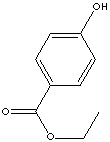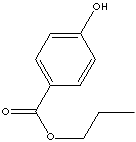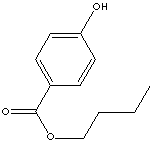|
PARABENS (METHYL, ETHYL, PROPYL, BUTYL) | ||||||||||||||||||||||||||||||||||||||||||||||||||||||||||||||
|
GENERAL DESCRIPTION | ||||||||||||||||||||||||||||||||||||||||||||||||||||||||||||||
|
Benzoic acid,
the simplest aromatic carboxylic acid containing carboxyl group bonded directly
to benzene ring, is a white, crystalline organic compound; melting at 122 C
(starting sublime at 100 C); boiling at 249 C; slightly soluble in water,
soluble in ethanol, very slightly soluble in benzene and acetone. Its aqua
solution is weakly acidic. It occurs naturally in many plants and resins.
Benzoic acid is also detected in animals. The most of commercial benzoic acid is
produced by the reaction of toluene with oxygen at temperatures around 200 C in
the liquid phase and in the presence of cobalt and manganese salts as catalysts.
It can be prepared also by the oxidation of benzene with concentrated sulphuric
acid or carbon dioxide in the presence of catalysts. Other methods are such as
by the oxidation of benzyl alcohol, benzaldehyde, cinnamic acid; by hydrolysis
of benzonitrile, benzoyl chloride. More than 90% of commercial benzoic acid is
converted directly to phenol and caprolactam. Its use in the production of
glycol benzoates for the application of plasticizer in adhesive formulations is
increasing. It is also used in the manufacture of alkyd resins and drilling mud
additive for crude oil recovery applications. It is used as a rubber
polymerization activators and retardants. Benzoic acid is converted to its salts
and esters for the use of preservative application in foods, drugs and personal
products. Sodium benzoate, sodium salt of benzoic acid, is used preferably as
one of the principal anti-microbial preservatives used in foods and beverages
(but it's concentration is limited usually not exceeding 0.1% because it is
poisonous), as it is about 200 times more soluble than benzoic acid. Sodium
Benzoate is also used in medications, anti-fermentation additives and tabletting
lubricant for pharmaceuticals. The industrial applications are as a corrosion
inhibitor, as an additive to automotive engine antifreeze coolants and in other
waterborne systems, as a nucleating agents for polyolefin, as a dye
intermediate, as a stabilizer in photographic processing and as a catalyst. Wide
range of benzoic esters are used as solvents, dying carrier, disinfectant
additive, penetrating agent and pesticides and manufacturing other compounds.
Benzoic acid derivatives substituted by hydroxy group or ether containing oxygen atom have active bacteriostatic and fragrant properties. They are typically used in pharmaceutical and perfumery industry. The destructive metabolic property of oxygen containing benzoic acid derivatives such as protocatechuic acid (3,4-dihydroxybenzoic acid) and veratric acid (3,4-dimethoxybenzoic acid) is used in the application for pharmaceuticals. Protocatechuic acid is a catabolite of epinephrine. Prazosin, a peripheral vasodilator and antihypertensive, is also an example of the applicaion of veratric acid. Hydroxy and ether substituted benzoic acids feature analogue metabolite of aspirin (acetylsalicylic Acid). They are used as intermediates for pharmaceuticals (especially for antipyetic anlgesic, antirheumatism) and other organic synthesis. They are used as matrix for ionization of peptides, proteins and carbohydrates. Estesrs of hydroxybenzoic acid are recognized as antiseptics. Especially parabens, substituted at 1,4 position, are widely used as preservatives in food and pharmaceuticals. |
||||||||||||||||||||||||||||||||||||||||||||||||||||||||||||||
|
PRODUCT IDENTIFICATION | ||||||||||||||||||||||||||||||||||||||||||||||||||||||||||||||
|
METHYL PARABEN |
CAS
NO. : 99-76-3 |
|
||||||||||||||||||||||||||||||||||||||||||||||||||||||||||||
|
ETHYL PARABEN |
CAS
NO. : 120-47-8 |
|
||||||||||||||||||||||||||||||||||||||||||||||||||||||||||||
|
PROPYL PARABEN |
CAS
NO. : 94-13-3 |
| ||||||||||||||||||||||||||||||||||||||||||||||||||||||||||||
|
BUTYL PARABEN |
CAS
NO. : 94-26-8 |
|
||||||||||||||||||||||||||||||||||||||||||||||||||||||||||||
|
SPECIFICATION | ||||||||||||||||||||||||||||||||||||||||||||||||||||||||||||||
| ||||||||||||||||||||||||||||||||||||||||||||||||||||||||||||||
|
SYNONYMS |
||||||||||||||||||||||||||||||||||||||||||||||||||||||||||||||
|
METHYL PARABEN |
Methyl 4-hydroxybenzoate; Methyl Chemosept; Methyl Parasept; 4-Hydroxybenzoic acid methyl ester; Nipagin M; Tegosept M; Aseptoform; Nipagin; 4-Hydroxy methyl benzoate | |||||||||||||||||||||||||||||||||||||||||||||||||||||||||||||
|
ETHYL PARABEN |
Ethyl 4-hydroxybenzoate; 4-Hydroxybenzoic acid ethyl ester; Nipagin A; Ethyl Parasept; Solbrol A | |||||||||||||||||||||||||||||||||||||||||||||||||||||||||||||
|
PROPYL PARABEN |
Nipasol; Propyl Chemosept; Solbrol P; Propyl Parasept; Propyl 4-hydroxybenzoate; 4-Hydroxybenzoic acid propyl ester; p-hydroxy propyl benzoate; n-propyl p-hydroxybenzoate; aseptoform p; betacide p; paseptol; propyl aseptoform; protaben p; tegosept p; 4-hydroxybenzoic propyl ester | |||||||||||||||||||||||||||||||||||||||||||||||||||||||||||||
|
BUTYL PARABEN |
n-Butyl paraben; n-Butyl p-Hydroxybenzoate; Butyl 4-hydroxybenzoate; Butoben; Butyl Chemosept; Butyl Parasept; p-hydroxybenzoic acid n-butyl ester; 4-(butoxycarbonyl)phenol; aseptoform butyl; butyl tegosept; nipabutyl; solbrol b; tegosept butyl; butyl butex; p-Hydroxy butyl benzoate; 4-Hydroxybenzoic acid butyl ester | |||||||||||||||||||||||||||||||||||||||||||||||||||||||||||||
|
COMMENTS |
||||||||||||||||||||||||||||||||||||||||||||||||||||||||||||||
A preservative is an additive for foods, pharmaceuticals, personal
care products, cosmetics and other
industrial products to reduce spoilage that air, fungi, bacteria, or yeast
can cause. Members
of common preservative
for foods, pharmaceuticals, personal care products
and cosmetics include:
|
||||||||||||||||||||||||||||||||||||||||||||||||||||||||||||||
|
PRICE INFORMATION |
||||||||||||||||||||||||||||||||||||||||||||||||||||||||||||||
|
|
||||||||||||||||||||||||||||||||||||||||||||||||||||||||||||||



